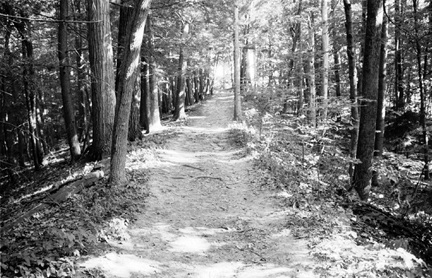Matthew Buckingham

Still image from “Amos Fortune Road” Black and White 16mm film with sound. 20 mins. 1996
Matthew Buckingham is an artist that lives and works in New York.
His pieces usually tie the usage of a film projector and how history/memories are linked through experiences and images. To question the links to the past and how within the ‘place’ we are constantly referred back into the present.
Amos Fortune Road (1996)
Usage of texts throughout the piece that tells in fragments, the moments of a woman’s life by the name of Sharon and her theater job at a camp over the summer. Then the plot deals with her fascination of Amo’s Fortune – a former slave and his connection to her daily route to school.
The exploration of the work is in the attachment to space within a moving image versus a static image. A relationship with every site with degrees of importance due to memory. A literal/imaginary connection is what is important to the piece.
The biography availability to the audience creates the option to “unravel” the truth/source behind the work.
The black card with text.
The still image.
The still image within the moving image.
and their relationship with the basis of time and creation of attention.
Notes on Matthew Buckingham
Walker Evans – referenced artist who uses this technique to depict the moving image in different instances of time.
From a lecture on November 15th, 2010 at MICA.
The problems of representation in non-fiction work are really “what is possible and not-possible” in the usage of non-fiction in the art world. The questions in the Post-Modern art movement were very interesting, especially in photojournalism. Most of Matthew Buckingham's works deal with memory and time and with the de-familiarization of the structures that are made up of memory and time. He also mentions the differences between History and historiography – history from below “understanding the past through personal experience” and History from the top-down “history of the monarchies of states.”
These forms of history that attempt to define “where are we?” which is the essence of his own artistic practice.
"How do we use the past to define our current position?"
Susan Buck-Morss, a writer whose work “The Dialectics of Seeing” was very influential to Matthew Buckingham. “Vanishing point of history is leading up to the current moment.”
The present moment is the focus of history. The 3-4 seconds of what we consider “the present moment.” All sentient design might be experiencing this vanishing point differently. He has an Interest in the re-enactment, a popular pass-time rendition of "re-enactment" is pretending to be in the military and simulating battles through history.
Matthew’s specific interest being in how the re-enactment changes from the historical event. (The lack of bloodshed or death). The narrative within a re-enactment is structured to create a space that is devoid of 99% of the rest of the world.